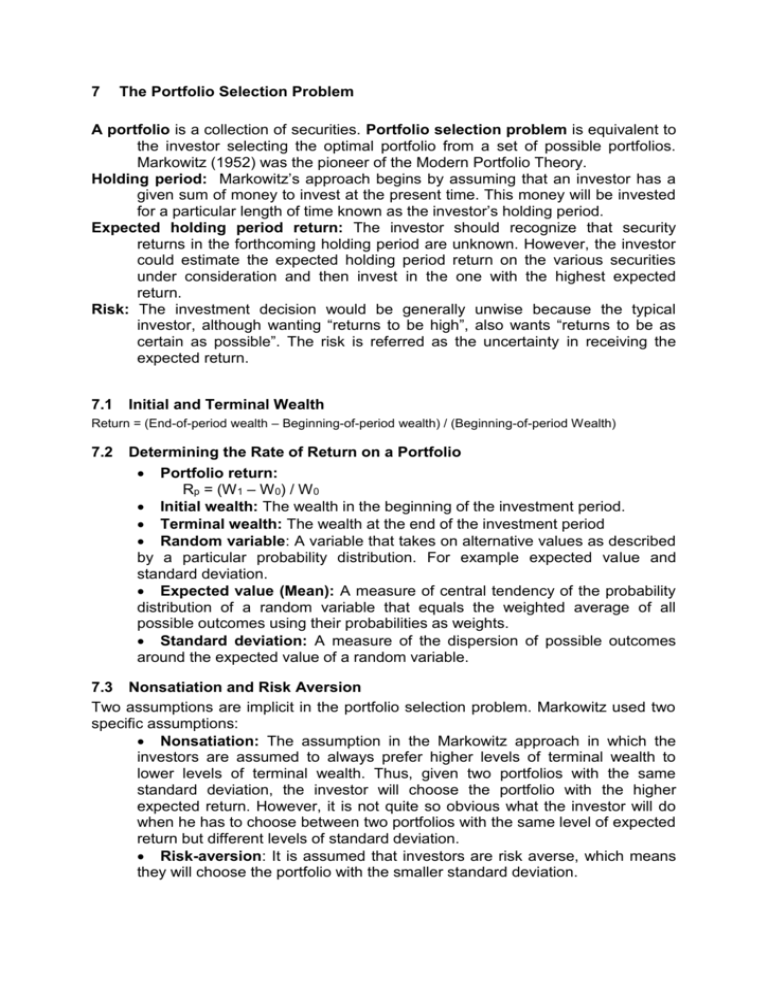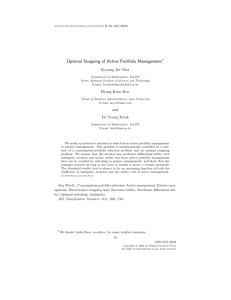The Portfolio Selection Problem (CH 7)
advertisement

7 The Portfolio Selection Problem A portfolio is a collection of securities. Portfolio selection problem is equivalent to the investor selecting the optimal portfolio from a set of possible portfolios. Markowitz (1952) was the pioneer of the Modern Portfolio Theory. Holding period: Markowitz’s approach begins by assuming that an investor has a given sum of money to invest at the present time. This money will be invested for a particular length of time known as the investor’s holding period. Expected holding period return: The investor should recognize that security returns in the forthcoming holding period are unknown. However, the investor could estimate the expected holding period return on the various securities under consideration and then invest in the one with the highest expected return. Risk: The investment decision would be generally unwise because the typical investor, although wanting “returns to be high”, also wants “returns to be as certain as possible”. The risk is referred as the uncertainty in receiving the expected return. 7.1 Initial and Terminal Wealth Return = (End-of-period wealth – Beginning-of-period wealth) / (Beginning-of-period Wealth) 7.2 Determining the Rate of Return on a Portfolio Portfolio return: Rp = (W 1 – W 0) / W 0 Initial wealth: The wealth in the beginning of the investment period. Terminal wealth: The wealth at the end of the investment period Random variable: A variable that takes on alternative values as described by a particular probability distribution. For example expected value and standard deviation. Expected value (Mean): A measure of central tendency of the probability distribution of a random variable that equals the weighted average of all possible outcomes using their probabilities as weights. Standard deviation: A measure of the dispersion of possible outcomes around the expected value of a random variable. 7.3 Nonsatiation and Risk Aversion Two assumptions are implicit in the portfolio selection problem. Markowitz used two specific assumptions: Nonsatiation: The assumption in the Markowitz approach in which the investors are assumed to always prefer higher levels of terminal wealth to lower levels of terminal wealth. Thus, given two portfolios with the same standard deviation, the investor will choose the portfolio with the higher expected return. However, it is not quite so obvious what the investor will do when he has to choose between two portfolios with the same level of expected return but different levels of standard deviation. Risk-aversion: It is assumed that investors are risk averse, which means they will choose the portfolio with the smaller standard deviation. 7.4 Utility The exact relationship between utility and wealth is called the investor’s utility of wealth function. Utility: The relative enjoyment or satisfaction that people drive from economic activity such as work, consumption, or investment. People are presumed to be rational and to allocate their resources (such as time and money) in ways that maximize their own utilities. The Markowitz portfolio selection problem can be viewed as an effort to maximize the expected utility associated with the investor’s terminal wealth. Marginal utility: A unique increment of utility from an extra dollar of wealth. The marginal utility may differ among investors. Further, that marginal utility may depend on the level of wealth that the investor possesses before receiving the extra dollar. Diminishing Marginal Utility: A common assumption is that investors experience diminishing marginal utility of wealth. Each extra dollar of wealth always provides positive additional utility, but the added utility produced by extra dollar becomes successively smaller. The assumption of nonsatiation requires that the utility of wealth function is always positively sloped no matter what the level of wealth. However, this utility of wealth function is concave. An investor with diminishing marginal utility is necessarily risk-averse. This riskaverse investor is unwilling to accept a fair bet. The utility of wealth function explains that preference. Certainty equivalent: Moving horizontally from the utility axis at the expected utility of the risky investment to the utility of wealth function and then moving down to the terminal wealth axis indicates certainty equivalent wealth associated with this risky investment. Risk premium: The additional dollar amount in expected terminal wealth offered by the risky investment over the certain investment. 7.5 Indifference Curves Indifference curve: A set of risk and expected return combinations that provide an investor with the same amount of utility. The investor is indifferent about the risk – expected return combinations on the same indifference curve. Because indifferent curves indicate an investor’s preferences for risk and expected return, they can be drawn on a two-dimensional figure where the horizontal axis indicates risk as measured by standard deviation, and the vertical axis indicates reward as measured by expected return. Because all portfolios that lie on a given indifference curve are equally desirable to the investor, by implication indifference curves cannot intersect. 7.6 Calculating Expected Returns and Standard Deviation for Portfolios The expected return on a portfolio consisting of N securities: _ N _ rp X i r i i 1 _ rp = the expected return of the portfolio Xi = the proportion of the portfolio’s initial value invested in security i _ ri = the expected return of security i N = the number of securities in the portfolio Expected return vector: Used to calculate the expected return for any portfolio formed from the N securities. This vector consists of one column of numbers, where the entry in row i contains the expected return of security i. Probability distribution: A model describing the relative frequency of possible values that a random variable can assume. Normal distribution: A symmetrical bell-shaped probability distribution, completely described by its mean and standard distribution. The clearest example arises when the probability distribution for a portfolio’s return can be approximated by the familiar bell-shaped curve known as a normal distribution. Standard deviation of a portfolio: p N N i 1 j 1 X i X j ij Covariance: A statistical measure of the relationship between two random variables and of how to random variables, such as the returns on securities i and j, “move together”. Correlation coefficient: Rescales the covariance to facilitate comparison with corresponding values for other pairs of random variables and lies between –1 and +1. ij = ij / (i j) Variance: The standard deviation of security i squared. Variance – covariance matrix: Column1 Column2 Column3 Row1 146 187 145 Row2 187 854 104 Row3 145 104 289 Cell (i,j) : Covariance between security i and j Cell (i,i) : Variance of security i









